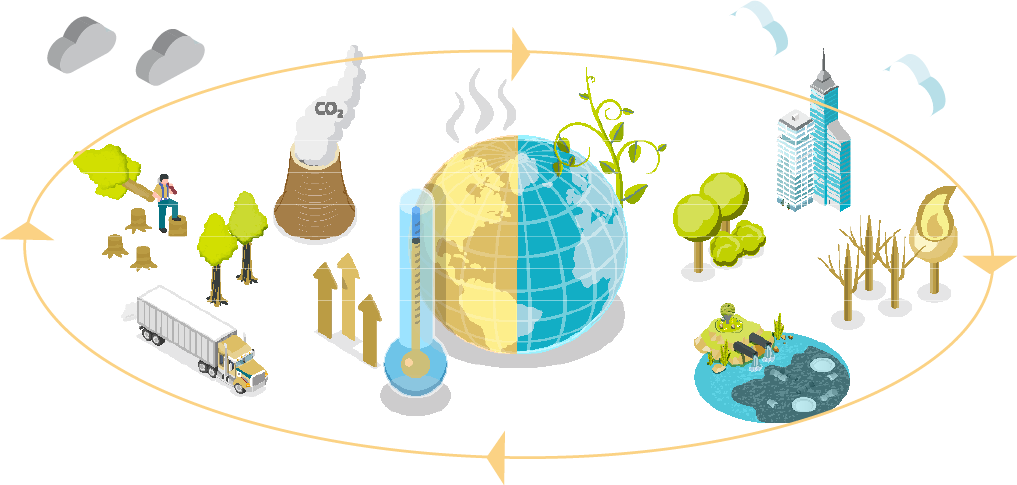
Tackling three main drivers of biodiversity loss with listed equities
Global human population is increasing rapidly. This is in turn driving greater biodiversity loss, as more species are lost due to increased human resource and habitation requirements.
The size and breadth of biodiversity loss must be halted and addressed now, and on a sufficient scale to achieve the targets arising from the COP15 biodiversity agreement2. This scalability can be achieved through investing in listed equity companies.
There is no net zero without nature

The agriculture sector is to biodiversity what the energy sector is to climate change – namely, its biggest challenge.
Efficient and precise production is becoming a top priority as well as reducing food waste to achieve a more sustainable agriculture system, allowing farmers to use less scarce land and water resources as well as reducing pollution from chemical fertilisers and pesticides.

|
80% of deforestation is linked to agriculture3 |

|
1/3 of the food produced is wasted |
Changing human food consumption is key
This massive land use only fulfils 17% of calories needed globally4 and only provides 33% of global protein4
Fresh Water scarcity

|

|

|
Most of the water on Earth is saltwater, with freshwater making up just 3%5 |
15% of our water supply is lost every year6 |
70% of all fresh water is used by agriculture7 |
Innovative technology such as smart metering and analytics help increase the efficiency of water systems by identifying leaks and reducing water loss.
By 2050 there could be more plastic than fish in the sea8
Fossil-fuel derived plastic dominates the packaging market. Manufacturers are working on the superior circularity features of aluminium and glass.
Consumer behaviour is changing to lessen environmental impact
Digital peer-to-peer platforms promote pre-owned goods, can reduce waste, and promote more sustainable consumption

|
Innovations
|
As we move to a net-zero economy, recycling of scarce resources will need to increase to meet demand as well as reduce the impact on the environment
Sources:
- (1) WWF Living Planet Report 2022. For illustrative purposes only
- (2) https://www.unep.org/news-and-stories/story/cop15-ends-landmark-biodiversity-agreement
- (3) Citi GPS, Food and Climate Change, 2022
- (4) Ibid.
- (5) BofAM, The World Is Not Enough - Scarcity Primer, 2022
- (6) Ibid.
- (7) WWF, 2022
- (8) BofAM, The World Is Not Enough - Scarcity Primer, 2022
- (9) https://www.circularonline.co.uk/news/62-of-businesses-to-invest-more-in-sustainable-packaging-materials/
- (10) BofAM, IEA, Growth of selected minerals in 2040 vs 2020 in «Sustainable Development Scenario».
Disclaimer
This document is for informational purposes only and does not constitute investment research or financial analysis relating to transactions in financial instruments as per MIF Directive (2014/65/EU), nor does it constitute on the part of AXA Investment Managers or its affiliated companies an offer to buy or sell any investments, products or services, and should not be considered as solicitation or investment, legal or tax advice, a recommendation for an investment strategy or a personalized recommendation to buy or sell securities.
Due to its simplification, this document is partial and opinions, estimates and forecasts herein are subjective and subject to change without notice. There is no guarantee forecasts made will come to pass. Data, figures, declarations, analysis, predictions and other information in this document is provided based on our state of knowledge at the time of creation of this document. Whilst every care is taken, no representation or warranty (including liability towards third parties), express or implied, is made as to the accuracy, reliability or completeness of the information contained herein. Reliance upon information in this material is at the sole discretion of the recipient. This material does not contain sufficient information to support an investment decision.
Issued in the U.K. by AXA Investment Managers UK Limited, which is authorised and regulated by the Financial Conduct Authority in the U.K. Registered in England and Wales, No: 01431068. Registered Office: 22 Bishopsgate, London, EC2N 4BQ
In other jurisdictions, this document is issued by AXA Investment Managers SA’s affiliates in those countries.